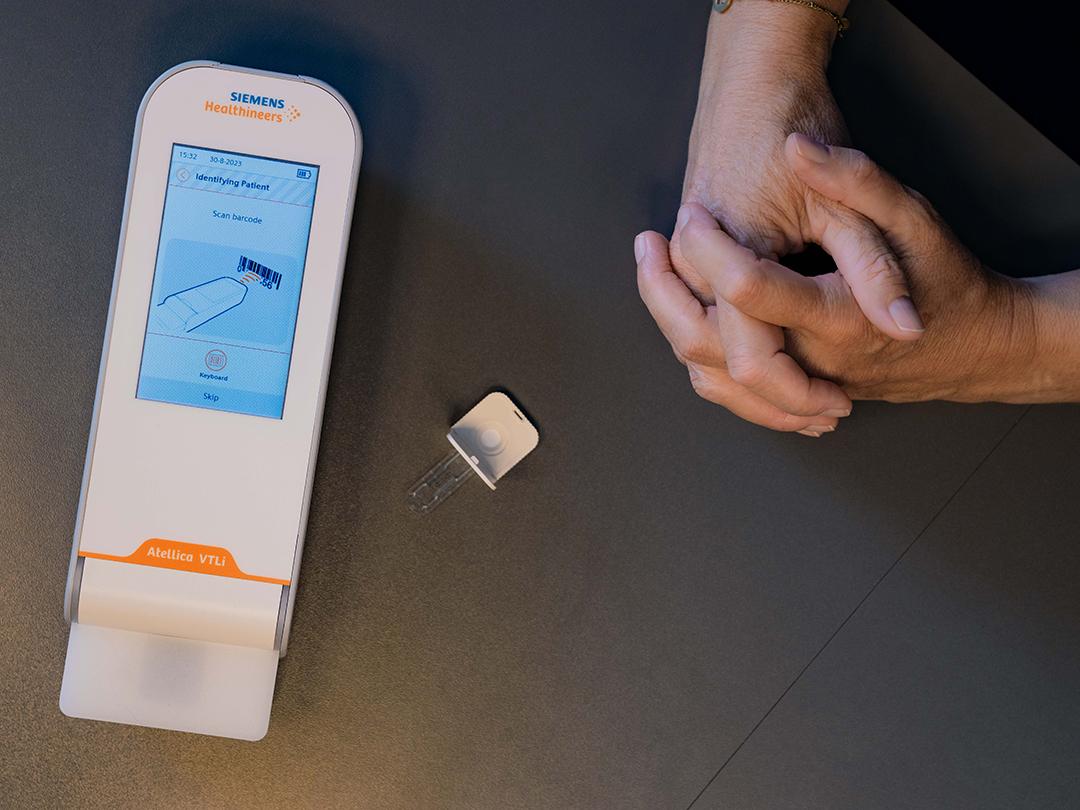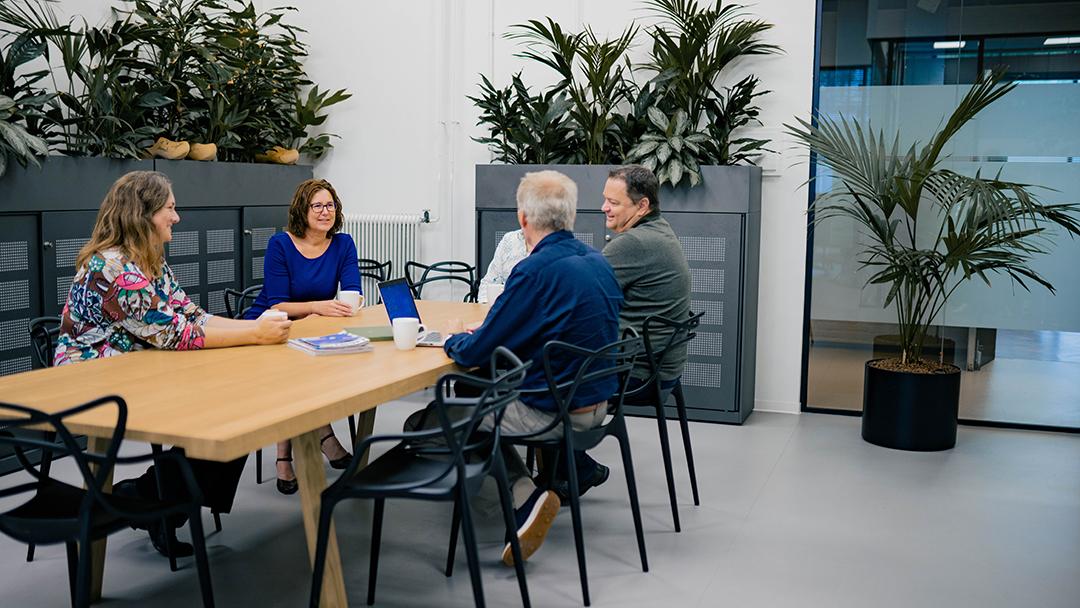Home
Perspectives
- Heartfelt innovation for emergency care
Heartfelt innovation for emergency care
Femke de Theije and her team are taking heart attack diagnosis from an hour to eight minutes.
Femke de Theije and team chose to follow their hearts and, in doing so, are helping to save the hearts of others: They developed a handheld device that reduces heart attack diagnosis from one hour down to eight minutes.
"It’s a pretty cool technology!" As she speaks those words, her posture becomes even a bit more upright. De Theije flashes a broad smile and it’s clear she's very proud of what she and her team have accomplished.You can't help but smile a little yourself – de Theije's enthusiasm is contagious.
We're in Eindhoven, the Netherlands, in the middle of the local High Tech Campus. Our goal is to learn how de Theije and team plan to revolutionize emergency care – with a handheld device that fits in the pockets of the emergency teams’ scrubs.













A handheld device to relieve patients and care teams
“Our device can help to determine if someone is having a heart attack, in just eight minutes and with a fingerstick of blood,” says de Theije. Traditionally, to get results that help doctors make a diagnosis you need an actual lab, a much larger blood sample collected via a venous blood draw and, well … time. It typically takes up to an hour to get the first lab results to find out if the patient who presented symptoms of a heart attack in the emergency department actually has one.
One hour vs. eight minutes – this is how it compares in detail:
What are the symptoms of a heart attack?
A heart attack, or myocardial infarction, happens when a part of the heart muscle doesn’t get enough blood. The more time that passes without treatment to restore blood flow, the greater the damage to the heart muscle. Some of the most common symptoms of a heart attack include: chest pain or discomfort, sometimes radiating to the arms, neck, jaw, back, or stomach, as well as shortness of breath, lightheadedness, nausea, and cold sweats. Women may experience other symptoms such as pain in the upper abdomen, nausea/vomiting, and back or jaw pain. Symptoms can vary greatly between individuals. Any unusual or persistent symptoms should be evaluated by a healthcare professional as soon as possible.
The typical 1 hour process via the lab ...
... vs. the 8 minutes process via our handheld device
The usage of the handheld device that gives test results in eight minutes could relieve a lot of stress for everyone involved:
- Patients don’t have to wait long for the results of their medical test and could get the right treatment faster, which increases their chances for recovery.
- Doctors can immediately act on the test result. In the case of a heart attack, every minute counts when it comes to limiting the damage to the heart muscle.
- The emergency care team can more quickly determine the people who need immediate medical attention from those who are not.
- The central lab team can focus on running the other medical tests that require the lab’s infrastructure and resources, while still being able to track the decentralized testing via the handheld devices in their central information system.
The simplified testing process and accelerated turnaround time from test to result also holds the potential to help address overcrowding in emergency departments, particularly in countries like the U.S., where it's a pressing issue.
Following her heart
De Theije has always been driven by her desire to do things that can substantially make a difference in people's lives. And “Follow your heart!” has become something like her mantra. She firmly believes that if your work doesn't ignite your passion, it's time for a change.
And she has taken her own advice: de Theije started out studying dentistry, because she always knew that in her job, she wanted to “make something better". But after “two years and one week”, she knew that taking care of people’s teeth was not for her: “I thought this is so boring, if I have to do this for the rest of my life, I’ll be miserable.”

"Follow your heart!
If you don’t like what you do, you must very quickly start doing something else, because your work takes a lot of energy and so you should put that in something that you really like."
- Femke de Theije
“I considered biology – but that was a bit too vague for me. So it was between math, physics and chemistry. And in chemistry they had the best atmosphere, so I joined them,” she says laughing. She also loves a challenge and finding things out herself. And for that, chemistry was a perfect match: A field so broad and varied that there was plenty to discover. She ended up doing her PhD in surface chemistry because she was drawn to the creative process of unraveling complex mechanisms: “That’s fulfilling for me because in the end, you really understand something. I like putting all those little pieces together to finish the puzzle.”
Revolutionizing emergency care with magnetic nanoparticles
When it comes to the technology, the team also had a puzzle to solve: Making a point-of-care device that can run a high-sensitivity troponin I test as well as a lab can. And that’s not easy: “Because the lab devices are getting better and better, so you have to compete with something that’s also improving constantly,” says de Theije. Traditional technologies turned out to be either too expensive to make or just not sensitive enough to measure troponin at lab quality.
So the team kept on searching for their missing puzzle piece. It turned out to be magnetism: "We are using magnetic nanoparticles that bind to troponin," explains de Theije. "By using magnetic forces, we draw those particles towards the surface where they can bind. The amount of bound particles on the surface is a measure for the troponin concentration in the blood sample." And this is how it works in detail:
What is a high-sensitivity troponin I test?
A high-sensitivity troponin I test is a type of blood test that is used to diagnose heart conditions, such as a heart attack. Troponin is a type of protein that is found in the heart muscle. When there is damage to the heart, such as during a heart attack, troponin is released into the bloodstream. High-sensitivity troponin tests are able to detect much smaller amounts of troponin in the blood than traditional tests. This means they can potentially detect heart damage sooner, and are also useful in ruling out a heart attack in people who have symptoms of one.
Inside Atellica VTLi – a fly-through
At Siemens Healthineers, we place a high value on innovation and the protection of these innovations through various types of intellectual property rights. Femke De Theije contributed to six inventions related to various aspects of the Magnotech Technology that have been filed as patent application. These inventions have led to the granting of 30 patents across various countries worldwide.
The protection of a patent is limited to the country where it has been filed, so Siemens Healthineers files applications in multiple jurisdictions to achieve a broader geographic scope of protection. The IP departments works in close collaboration with the Business to decide on the best filing strategy for every invention. This collaboration ensures that we can protect our innovations in relevant markets, while also managing costs effectively.
At the innovator’s kitchen table















Getting the product in the hands of emergency care teams worldwide
With over two decades of experience in biosensors, de Theije still enjoys diving into the intricacies of technology with her colleagues. In her current job, she acts more like a catalyst for collaboration: “I love bringing everyone together to create something useful – while having fun,” she says. As head of the R&D department for emergency care, her main goal is to get the device, called Atellica VTLi, in the hands of emergency care teams worldwide: “The innovation part is actually only a tiny portion of the work we do in R&D,” she explains. “In the end, it's probably not even that hard to come up with a very innovative idea. The harder part comes when you want to implement it and make your technology available.”
And that can require some patience: “These processes take time. Sometimes, you have to circle back and brainstorm fresh, creative ideas to address feedback from other teams – from the designers, the production team, from marketing and the customer support group. To launch a product successfully, you really need everyone's support.”




Looking into the future
In the end, de Theije, her team, and the colleagues that support them believe in the technology and know that all the work is worth it. “We’re convinced that our solution can really make an important contribution to enable better access to fast diagnosis,” she says. “Especially also at small hospitals, in rural areas, or care institutions in low- and middle-income countries, where they don’t have a big lab nearby.” In the future, they want to develop their technology further. Since Atellica VTLi is created as a platform, it could be expanded to test for more conditions where fast results matter.
As long as teams like de Theije’s keep following their heart and solving the puzzles of innovation with an open-minded, curious, and responsible approach, the future of emergency care shines a little brighter.
Share this page


- The products/features (mentioned herein) are not commercially available in all countries. Not available for sale in the U.S.A. Their future availability cannot be guaranteed.











